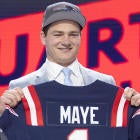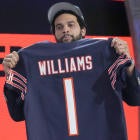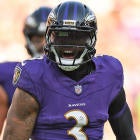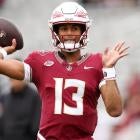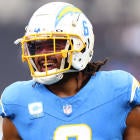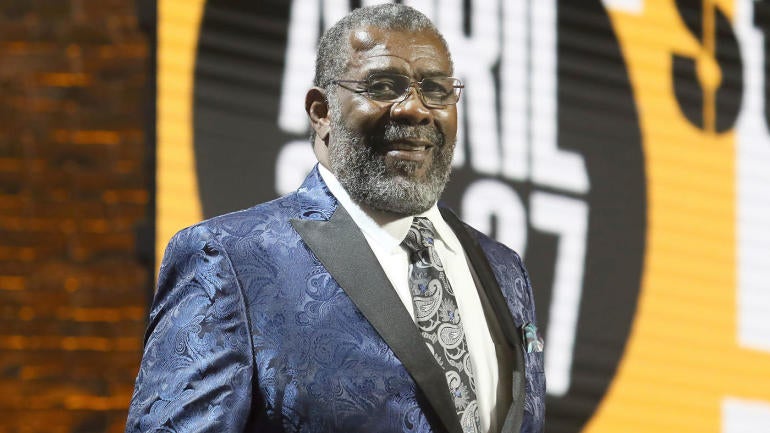
On Sept. 24, 1946, Charles Edward Greene was born in Temple, Texas. Over two decades later, "Joe" Greene would be one of the main cornerstones of one of the greatest dynasties in NFL history. A two-time Defensive Player of the Year, Greene led the Steelers to four Super Bowl wins over a six-year span from 1974-79. Greene, a first-ballot member of the Pro Football Hall of Fame, had his No. 75 jersey officially retired by the Steelers in 2014.
Along with his 13 seasons as a defensive tackle, Greene spent 17 seasons as an NFL assistant coach. He joined the Steelers' scouting department in 2004, where he won two more Super Bowl rings before retiring after the 2013 season. In 2019, he was the first defensive player named to the NFL's 100th anniversary all-time team.
Below are five fast facts about Greene on his 77th birthday:
How he adopted the names 'Joe' and 'Mean Joe'
During a 2014 interview with NFL Films, Greene said that his aunt nicknamed him Joe due to his resemblance to boxing legend Joe Louis, who at the time of Greene's birth was in the middle of his 12-year reign as heavyweight champion.
"She thought I was hefty and bulky enough to be called Joe Louis," Greene recalled. "She started calling me Joe, and it kind of stuck."
Greene was part of a dominant defense at North Texas State University (which is now the University of North Texas). During the 1966 season, members of the team's coaching staff started a chant in support of the defense that would later become the school's official nickname.
"We were way behind and (his mother) started hollering, 'Come on green, get mean,' or 'Here we go, mean green,' or variants on that," recalled Mark Graham, the son of then North Texas State sports information director Fred Graham, via the school's website. "Then it became popular with some of the students and some of the other fans. So it caught on."
The media began referring to the Eagles' defense as "Mean Green" in print in 1967. The nickname became used for the entire team in 1968. In 2000, each sports team at the school took on the Mean Green nickname. For Greene, the nickname followed him to Pittsburgh, who selected him with the fourth overall pick in the 1969 draft.
He threw a football in the stands during a game
Greene hated losing, so it was understandable that he wasn't thrilled about joining a Steelers team that had gone 2-11-1 the previous season. And while first-year coach Chuck Noll would eventually turn the Steelers into champions, his first team would win their first game ... before proceeding to lose their final 13. The first loss, a 41-27 setback in Philadelphia, set Greene into a fit of rage. After the Eagles clinched the game with a first down, Greene took the ball and threw it into the stands. His actions inspired Dan Rooney, the son of Steelers founder Art Rooney who was in his first season as the team's general manager.
"I said to my father, 'This guy is special. If he's that intense that he's going to do something like that, we've got a guy that we want," recalled Rooney, who passed away in 2017 after spending 27 years as the team's president and 28 years as owner.
Greene served as Rooney's Hall of Fame presenter in 2000.
Greene nearly quit the team in 1974
Greene's competitive fire nearly led to him leaving the Steelers during the '74 season. After a 13-10 loss to the Oilers in Week 12 dropped the Steelers to 8-3-1, Greene watched from home the following night as the two-time defending champion Dolphins dismantled the Bengals. Greene wondered aloud why his team couldn't be more like the Dolphins, who appeared to be on their way to a third consecutive title. The next day, Greene went to the Steelers' facility with the intention of leaving for good.
"I went to my locker and picked up my belongings and got into my car," Greene recalled during an NFL Films documentary on the 1974 Steelers. "My thoughts were that ... I don't know what they were, but I was leaving because I was disappointed. But in the midst of all of that, I said, 'Boy, I sure hope that somebody comes out here and stops me.'"
Somebody did come out to stop Greene. Lionel Taylor, the team's receivers coach who himself had been an All-Pro pass-catcher for the Broncos in the 1960s, convinced Greene to sit down and talk.
"He said down in the car and we talked," Greene recalled. "I don't know what we talked about, but anyway, I was glad we talked, because I went back. And that's when it started."
"It" was a run of success no NFL team enjoyed before or sense in the Super Bowl era. Pittsburgh did not lose again in 1974, as Greene led the charge to the Steelers' 16-6 victory over the Vikings in Super Bowl IX. Greene recorded an interception and a fumble recovery, as Pittsburgh's defense did not allow a single offensive point.
"To be a Steeler and wear the black and gold, it was special," Greene said about Pittsburgh's first Super Bowl win. "I think the journey is what made it so sweet. All the 13 [loss seasons] in my head, and the 'SOS: Same Old Steelers.' Golly, all of that stuff. That's what made that one so special, because it was the first and it brought Pittsburgh into the picture of football teams in the National Football League that, 'OK, you've got to deal with us now.'"
Mean Joe Greene 😤
— NFL Network (@nflnetwork) November 30, 2019
An anchor of the Steel Curtain is now cemented as a member on the #NFL100 All-Time Team!
📺: NFL 100 All-Time Team on NFL Network pic.twitter.com/Lumn0vG1hM
The co-creator of the Stunt 4-3
Late in the '74, Greene and defensive line coach George Perles created a new technique called the "Stunt 43" which immediately wreaked havoc on offenses. Instead of directly lining up against a lineman, Greene tilted his body while lining up between the guard and center. Teams were forced to commit so many blockers to Greene that his talented teammates often went unblocked. And even when they double and triple-teamed him, Greene more often than not found his way to opposing quarterbacks and receivers. The new technique helped the Steelers hold O.J. Simpson to 48 rushing yards in the divisional round, the Raiders to just 29 yards rushing in the AFC Championship Game, and the Vikings to 17 yards on 21 carries in Super Bowl IX.
Greene played half of his career with nerve damage
During the middle of his seventh season, Greene noticed a loss of feeling in his right arm and shoulder. Greene suffered permanent nerve damage to both parts of his body. His injury was apparent during that year's AFC Championship Game, when he was able to lift injured teammate Lynn Swann off of the field. Despite his weakened left arm, Greene won three more Super Bowls, was selected to four Pro Bowls and was named an All-Pro in 1977.
The famous Coca-Cola commercial
According to legend, Greene drank 18 bottles (equivalent to 2.25 gallons) of Coca-Cola during his iconic commercial that made its debut during the Steelers' 31-19 win over the Rams in Super Bowl. And while no one knows the whereabouts of the jersey Greene famously tossed to then-childhood actor Tommy Okon, Greene made sure his new friend got his No. 75 jersey.
"That Christmas, I got a package, and it was a signed Mean Joe Greene jersey," Okon said, "that I still have to this day."














